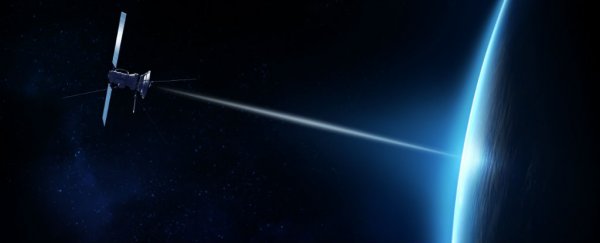As we explore further and further into the Solar System, reliable lines of communication are essential - otherwise there's no way that probes and spacecraft can report their findings or tweet about their experiences.
New technology recently installed on board the International Space Station (ISS) is designed to form the basis of an internet-style network spanning our cosmic neighbourhood. It's called DTN, or Delay/Disruption Tolerant Networking.
As TechCrunch's Devin Coldewey reports, DTN is a suite of protocols designed to cope with extended interruptions of connectivity, so it won't be phased by changes in orbit or the appearance of a planet that blocks communications as it makes it transit.
DTN is designed to be future-proof too, able to cope with an increased number of vehicles roaming the outer reaches of our Solar System, and making sure they can all 'phone home' no matter where they are or how long it's been since their last broadcast.
A network with DTN tech powering it uses a "store and forward" process, where data is split into chunks - it doesn't matter if the gaps between those chunks are drawn out, because the overall message can still be assembled at the other end.
It can even cope with those chunks arriving in the wrong order.

"Our experience with DTN on the space station leads to additional terrestrial applications especially for mobile communications in which connections may be erratic and discontinuous," said Google's Vint Cerf, a visiting scientist at NASA. "In some cases, battery power will be an issue and devices may have to postpone communication until battery charge is adequate."
The plan is to eventually extend the DTN network, so there are many different 'nodes' - or data relay stations - out there in the Solar System. These could be anything from manned space stations to floating satellites that can store data until it's ready to go. Anything that uses DTN could potentially become a new network node.
To encourage widespread adoption of these communication standards, many parts of DTN are available as open source code, which means other hardware and software developers can use and tweak them for free.
DTN has now been added to the Telescience Resource Kit (TReK) on board the ISS, which aims to simplify and improve communications between space and our Earth-based equipment. As the video above shows, it not only makes data transfer between several nodes more reliable, it makes it quicker too.
Vint Cerf, who was responsible for some of the protocols underpinning today's internet, has been thinking about an interplanetary version for some time, telling Adam Mann at Wired back in 2013, "In space, it takes a long time for the signal to even get to the destination let alone get an answer back. So network management turns out to be a lot harder in this environment."
Hopefully one day, Mars colonists will be able to open up their laptops and watch cat videos to avoid work, just like us.
